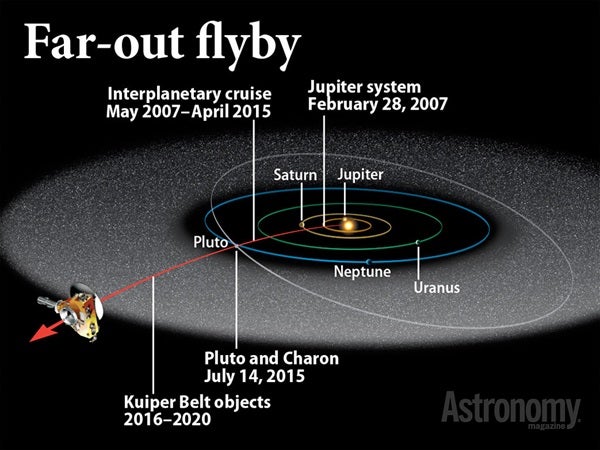Q: How does the New Horizons mission team intend to target additional objects in the Kuiper Belt, and how will the craft approach them after the Pluto system encounter?
A: While there is an incredible dispersion of orbits for objects in the Kuiper Belt, only an extremely small fraction of those bodies are potential targets for the New Horizons spacecraft. That’s because the fuel available for a post-Pluto trajectory change maneuver (which we call “TCM”) will allow the craft to fly by Kuiper Belt objects (KBOs) whose orbits bring them within only approximately 0.5° of the current New Horizons spacecraft trajectory.
And it’s not enough for the KBO trajectory to simply cross through this “acceptance cone.” That orbit must put the object at the right place when the New Horizons craft reaches that particular distance from the Sun.
Nevertheless, using what’s known about the population distribution in the Kuiper Belt, the New Horizons team calculates that there is a high probability — between 90 and 95 percent — that a KBO larger than about 30 miles (50 kilometers) in diameter should be available for a flyby. The encounter most likely would take place roughly three years after the Pluto encounter, which occurs in July 2015, when the spacecraft is approximately 42 astronomical units from the Sun. (One astronomical unit is the average Earth-Sun distance.)
But first we have to find at least one suitable KBO target using either large ground-based telescopes or the Hubble Space Telescope. Our team has been working on this problem intensively during the past couple of years, and we’ve discovered more than three dozen new KBOs but none located within the New Horizons acceptance cone. We’re continuing to search hard and still expect to find a targetable KBO during 2014. Stay tuned for that announcement!
After we discover such a KBO, we’ll execute a TCM, probably in late 2015, to put the spacecraft’s trajectory on a beeline toward that object. Approximately 40 to 50 days before the KBO encounter, the Long Range Reconnaissance Imager on New Horizons will start detecting the KBO, allowing us to refine the trajectory and maneuver the spacecraft to within approximately 16,000 miles (25,000km) of the KBO at the time of closest approach.
Hal Weaver
Johns Hopkins University Applied Physics Laboratory, Laurel, Maryland










